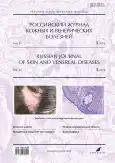Photogallery. Fungal lesions of skin and nails infections in HIV-associated immunodeficiency
- Authors: Prozherin S.V.1
-
Affiliations:
- Sverdlovsk Regional Center for Prevention and Control of AIDS
- Issue: Vol 27, No 5 (2024)
- Pages: 620-625
- Section: PHOTO GALLERY
- Submitted: 25.08.2024
- Accepted: 20.09.2024
- Published: 01.12.2024
- URL: https://rjsvd.com/1560-9588/article/view/635381
- DOI: https://doi.org/10.17816/dv635381
- ID: 635381
Cite item
Abstract
Against the background of any immunodeficiency, including that caused by HIV infection, the risk of developing superficial and invasive fungal diseases increases. Among people living with HIV, the most common fungal skin lesions are candidiasis, rubromycosis, and pityriasis versicolor. As immunosuppression worsens in HIV-positive patients not on antiretroviral therapy, the frequency and severity of mycoses increases. Thus, rubromycosis can spread beyond the feet, covering large areas of skin; sometimes the smooth skin of the hands, large folds, and areas of long hair growth are affected. In this case, the peripheral inflammatory ridge along the edge of the lesions, characteristic of rubromycosis, is sometimes absent.
According to some reports, over half of patients in the secondary disease stage of HIV infection suffer from onychomycosis. The progression of the disease often occurs in a short time. In addition to the nail plates of the feet, the nails on the hands are often affected. In patients with HIV infection who do not receive antiretroviral therapy, difficult-to-treat onychomycosis occurs.
Cryptococcosis is an opportunistic mycosis caused by yeast-like fungi Cryptococcus spp. It usually develops in HIV-positive individuals with a CD4+ T-lymphocyte level of less than 100 cells/μl. Skin lesions are usually secondary and indicate cryptococcal dissemination. Dermatological manifestations of cryptococcosis are varied. These may include papules and nodules surrounded by erythema and prone to ulceration, vesicular, pustular, herpetiform, acne-like rashes, ulcerative-necrotic lesions.
We present to your attention a photogallery of cases of fungal skin lesions that developed against the background of HIV-associated immunosuppression.
Full Text
About the authors
Sergey V. Prozherin
Sverdlovsk Regional Center for Prevention and Control of AIDS
Author for correspondence.
Email: rjdv@eco-vector.com
ORCID iD: 0000-0001-9956-4700
Russian Federation, Ekaterinburg
References
Supplementary files
















